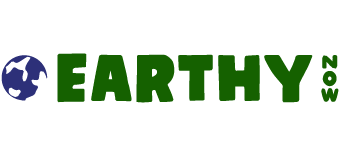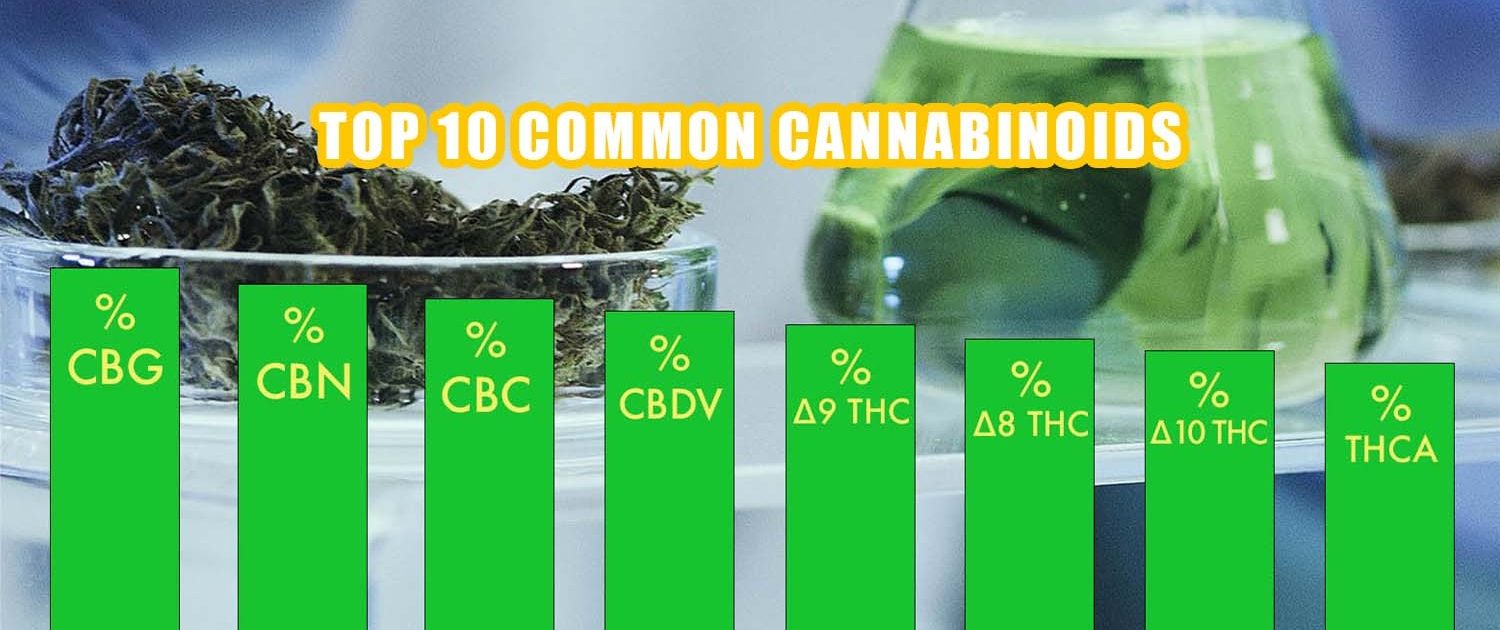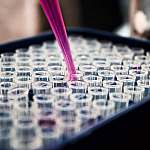Top 10 Common Cannabinoids
If you start paying attention to certificates of analysis (COA), you’ll see the top 10 common cannabinoids more often than others. Cannabis plants have around 540 chemical substances, and over 100 are cannabinoids [1].
What are cannabinoids?
Cannabinoids are simply “the chemical compounds of cannabis that have an effect on the human body when the plant is consumed [2].” They can have a lot of effects. Let’s first look at how that works.
What is the endocannabinoid system?
The effects are made possible because of the human endocannabinoid system that has evolved to create and use cannabinoids in our physiological processes.
It is a complex cell-signaling system which is integral for maintaining health. Its CB1 and CB2 receptors are found throughout the central nervous system and peripheral nervous system, in the brain, organs, connective tissues, glands, and immune cells of the human body [3].
Major cannabinoids may appear more often on COAs because they are naturally more abundant in the plant matter that created a product, or because they have been added as distillate or isolate during production.
Here are the 10 of the most abundant cannabinoids that appear on cannabis strains’ COAs, and what you should know about them.
What Minor Cannabinoids are the Most Popular? (Hint: CBC, CBN, CBG, and THCV)
Top 10 cannabinoids in the cannabis plant
CBD
Cannabidiol (ka-nə-bə-ˈdī-ȯl)
CBD is a cannabinoid discovered in 1940. It is often the most abundant cannabinoid in cannabis— THC and CBD are the top 2. CBD does not produce psychoactive effects like THC, and may even change THC’s effects on the body when both are present [4]. Check out our Guide to CBD for more info!
When interacting with the endocannabinoid system, CBD does not bind to CB1 and CB2 receptors. Rather, it interacts indirectly with the receptors through transient receptor potential vanilloid, or TRPV1 receptors [5].
There is interest and research in CBD but more high-quality evidence that it is effective may be needed before it is available more widely [4].
There is one U.S. Food and Drug Administration (FDA) approved version of CBD, called Epidiolex, available by medical prescription for use in treating seizures [6].
A common and easy way to use CBD is CBD Oil, and Earthy Now offers many varieties of Full-Spectrum, High-CBD, Low-THC Cannabis Oil.
Check out the CBD Pre-Rolls too!
CBG
Cannabigerol (kə-ˈna-bə-’ger-ȯl)
CBG is a non-psychoactive cannabinoid found in trace amounts in harvested and processed cannabis. Cannabigerolic acid (CBGa) is the precursor of cannabigerol (CBG), and is responsible for creating most downstream synthesized cannabinoids like THC and CBD [7].
Because of this CBG is lovingly called the “mother of all cannabinoids,” but since most of the CBGa is converted into cannabinoids, traditionally there is very little left in the plant upon harvest and use.
Therefore CBG has a high production cost and it can actually take thousands of pounds of biomass to yield a small amount of CBG isolate [8]. A 2018 study indicates that CBG is a regulator of endocannabinoid signaling [9], so it may have a small part to play in much of human physiology, but more research will tell.
CBN
Cannabinol (kə-ˈna-bə-nȯl)
CBN is a cannabinoid found in low concentration in the cannabis plant and is mainly a product of the aging of tetrahydrocannabinol acid (THCa). In aged cannabis, THCa in the plant converts to cannabolic acid (CBNa), and when decarboxylated by air, heat or light, converts to CBN [10].
CBN is sometimes considered to have psychotropic properties [11], and can have up to 25% potency compared to Delta-9 THC [12].
It is reported that CBN is sedative but proper studies are scarce [11]. CBN has shown potential, but again, more studies and data are needed before these are borne out as predictable distinct effects [12].
CBC
Cannabichromene (kə-ˈna-bə-ˈkrō-mēn)
CBC is a nonpsychoactive cannabinoid found in low to levels in cannabis. It reportedly does not affect the psychoactivity of THC, but does seem to have a different effect if THC is present [12]. Like CBD, CBC works through TRPV1 receptors and by stimulating CB2 receptors, but does not have significant activity at CB1 receptors [12]. CBC has been studied for its pharmacological uses [13], and is said to have significant potential based on existing research [12].
CBDV
Cannabidivarin (kə-ˈna-bə-ˈver-ən)
CBDV is a non-psychoactive cannabinoid found in low levels in cannabis [14]. It interacts with the body in various ways including via TRP receptors and CB1 receptors, the latter by affecting how the endocannabinoid system processes and modulates certain chemicals [12]. There is not much data available about CBDV’s uses, but it has shown potential [12].
∆9 THC
Delta-9-Tetrahydrocannabinol (ˈdel-tə |ˈnīn | te-trə-hī-drə-kə-ˈna-bə-ˌnȯl)
∆9 THC is the main psychoactive compound in cannabis and was discovered in 1964. It is often the most prominent compound in cannabis plants, but THC levels vary quite a bit. Read the Guide to hemp derived Delta-9 THC for more info.
The 2014 and 2018 Farm Bills revised the definitions of hemp and marijuana. Now, cannabis with less than 0.3% Delta-9 THC is defined as hemp, and cannabis with more than 0.3% Delta-9 THC is federally defined as marijuana.
Prior to the revised definition of hemp, the word “THC” used alone often referred to ∆9 THC, even though there are other types of THC (see below).
∆9 THC interacts with the endocannabinoid system via CB1 and CB2 cannabinoid receptors, some of which are located throughout the body including parts of the brain that affect “thinking, memory, pleasure, coordination and movement [15].” THC has been widely studied and used for medical reasons [19]. Nabiximols, aka trade name Sativex, is a medical preparation of THC, made by GW Pharmaceuticals [16]. It is available for prescription in 25 countries, and is being tested for use in the United States [17].
Love Potion #9: Delta-9 THC and Sex Drive
∆8 THC
Delta-8-Tetrahydrocannabinol (ˈdel-tə |ˈāt | te-trə-hī-drə-kə-ˈna-bə-ˌnȯl)
∆8 THC occurs naturally in the cannabis plant, but in low quantities. It has a double bond on the 8th carbon chain, and Delta-9 has a double bond on the 9th carbon chain. This small distinction is enough to produce slightly different cognitive and physical effects [18]. Research in 1973 compared Delta-8 to Delta-9 THC and reported that Delta-8 produced effects similar to Delta-9, at a third less potency [19].
The Federal Drug Administration (FDA) additionally stated that Delta-8 THC has psychoactive and intoxicating effects, similar to Delta-9 THC, and that concentrated amounts of Delta-8 THC are typically manufactured from hemp-derived CBD [20]. Modern Delta-8 products have been called “marijuana-light” and “diet weed” which aligns with these findings.
Purchase premium Delta-8, Delta-9, and Delta-10 from Earthy Select.
∆10 THC
Delta-10-Tetrahydrocannabinol (ˈdel-tə |ˈten | te-trə-hī-drə-kə-ˈna-bə-ˌnȯl)
∆10 THC is another cannabinoid that occurs in low levels in cannabis. Following the pattern, it has its double bond on the 10th carbon chain, and is reported to have similar but lower intensity effects to Delta-9. Delta-10 has been described as a mood-enhancer [21]. Not much data is available on the effects of Delta-10 on the body. Delta-10 THC is not easy to manufacture and must be refined extensively, so you usually don’t see it in abundance. Because of this, a lot of products combine Delta-10 with Delta-8 [22].
The Differences Between Delta-8, Delta-9, and Delta-10 THC: What You Need to Know
THCA
Tetrahydrocannabinolic acid (te-trə-ˌhī-drə-kə-ˈna-bə-nȯl-ˈik |ˈa-səd)
THCA, or tetrahydrocannabinolic acid, is the non-psychoactive acidic precursor to THC found in raw and live cannabis. “In its natural state, the cannabis plant goes through a vegetative and then flowering stage where it produces cannabigerolic acid (CBGA), the source of many cannabinoids. Enzymes called synthases convert CBGA into THCA and other cannabinoids such as CBDA or CBCA before being converted to their parent compounds [23].” As the plant dries, the THCA slowly converts to THC, and heat expedites this conversion through a process known as decarboxylation [24].
THCA may indeed have therapeutic benefits but academic studies are limited. Research published in 2017 found that THCA’s clinical use may be hampered by its relative instability due to minimal binding affinity at CB1 [25]. On the other hand, there is interest from the industry in continuing research and developing applications for this common cannabinoid.
THCV
Tetrahydrocannabivarin (te-trə-ˌhī-drə-kə-ˈna-bə-ˈver-ən)
THCV is found in cannabis alongside THC but it is not clear whether it is psychoactive [26]. THCV interacts with the endocannabinoid system via the CB1 receptor and to a lesser extent, on the CB2 receptor [27]. A theory is that since THCV can block the CB1 receptor, known to stimulate appetite, it could reduce appetite. Preliminary evidence for this is based on animal research and more published scientific studies may be needed to support these benefits in humans [26].
Parting thoughts on the top 10 cannabinoids
Now you know more about THC and CBD and the other cannabinoids native to cannabis cultivars, some with psychoactive properties and some without. Cannabinoid research continues. These and additional important cannabinoids hold massive potential for human benefits. Order premium cannabis goods for direct delivery.
Medical Disclaimer / Legal Disclaimer – Information is provided for educational purposes. It does not and is not intended to constitute legal advice or medical advice. We attempt to be accurate and up-to-date, but the legality of cannabinoids and the science of cannabis are evolving. The author is neither a legal professional nor a medical expert. Before buying or using any products, you should check with your local authorities and medical providers.
References
- Cannabis, Marijuana and Cannabinoids What You Need to Know
- Cannabinoids
- Getting High on the Endocannabinoid System
- Cannabidiol
- Cannabinoid receptors: where they are and what they do?
- https://www.epidiolex.com/
- CBG the Mother of All Cannabinoids with Broad Antibacterial Activity
- CBG vs CBD What Are the Differences?
- Cannabigerol Action at Cannabinoid CB1 and CB2 Receptors and at CB1–CB2 Heteroreceptor Complexes
- How to Extract CBN Oil
- CBD vs CBN Benefits and Uses
- Cannabis Pharmacology: The Usual Suspects and a Few Promising Leads
- Cannabichromene
- Cannabidivarin
- Tetrahydrocannabinol
- Nabiximols
- Sativex Nabiximols Phase 3 Trial Cannabis Extract Treatment MS
- Delta-8 Cannabidnoid How Its Made Extraction Testing Measuring
- Delta-8- and Delta-9-tetrahydrocannabinol; Comparison in Man by Oral and Intravenous Administration
- FDA 5 Things Know About Delta-8 Tetrahydrocannabinol Delta-8 THC
- Latest Cannabinoid in the Spotlight: Delta-10 THC
- What Is Delta-10?
- THCA Isolate
- What Is THCA?
- Affinity and Efficacy Studies of Tetrahydrocannabinolic Acid A at Cannabinoid Receptor Types One and Two
- Substance Use THCV
- Tetrahydrocannabivarin
Frequently Asked Questions
Will CBD products show up in a drug test?
There is a risk of failing a drug test. It depends on the type of CBD product one is using.
Drug tests for cannabis generally identify THC or its metabolites. Although tests do not screen for CBD, full spectrum CBD products contain low quantities of THC that can make a person fail a drug test. If you anticipate taking a drug test, we suggest checking with your employer or test administrator for clarity prior to taking full spectrum CBD products.
Is it legal to send CBD products through the mail?
Yes, but even though CBD products are federally-compliant, individual states may have their own regulations about purchasing or using hemp-based products and certain cannabinoids, and these are subject to change. You should check your state and local rules about THC and CBD before ordering.
What does “hemp-derived” mean?
Hemp-derived means made from hemp, sometimes also referred to as industrial hemp. The Farm Bills established new federal legal definitions and rules for hemp, including that hemp and “and any part of that plant, including the seeds thereof and all derivatives, extracts, cannabinoids, isomers, acids, salts, and salts of isomers, whether growing or not, with a delta-9 tetrahydrocannabinol concentration of not more than 0.3 percent on a dry weight basis” may be used for production, sales, transport, and use.
How do I know how much is the correct dosage?
While products have a suggested dosage listed on each package, the strength of the effects on a particular person will be different depending on a few things: the dosage level, body weight, food or other substances in the system, personal body chemistry, and experience level with cannabis products.
High CBD, low THC cannabis can produce a range of effects from clear-headed alertness & energy to calm & relaxation.
Generally speaking, it is recommended that you start with the lowest dose and gradually increase it until you reach satisfactory results. Consult your healthcare provider with specific questions about using any products.




